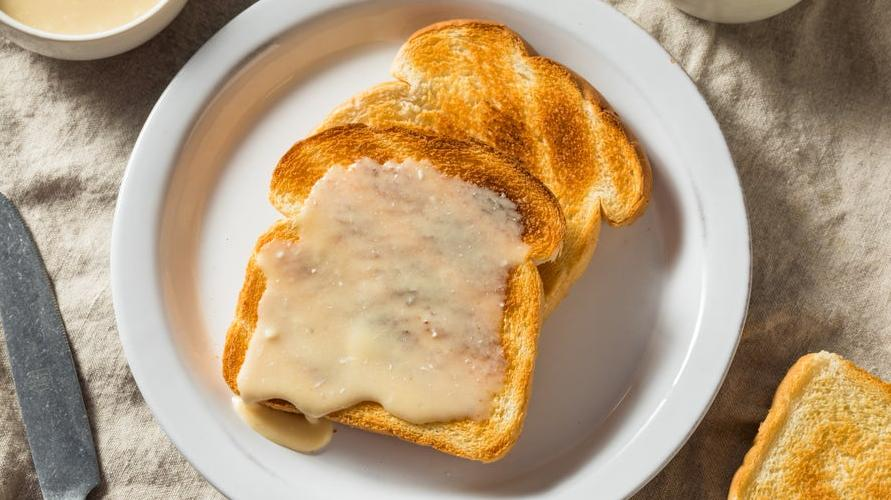Get A Head Start On Fall Flavors With Maple Cream
Vermont maple syrup takes more forms than you think.
Vermont, I'm sorry I never knew your glory until now. Having visited the area for the very first time last weekend, I am delighted to discover that the Green Mountain State is every bit as idyllic as the rest of the country imagines it to be: rolling green hills, quaint-as-hell bookshops, lambs staying cool in the shade of a pickup truck... and yes, tons of cheddar cheese and maple syrup for the tourists to enjoy. But because I am not a pancakes kind of gal, it was maple cream, not maple syrup, that stole my heart.
I picked up a jar of maple cream at Mother Myrick's Confectionery in Manchester, its label devoid of any useful information. No ingredients list, no suggested pairings, and no explanation of what, exactly, I was buying. When I investigated further, I found that maple cream really doesn't need an ingredients list at all, because it is composed of only one ingredient: grade A maple syrup.
What is maple cream?
The Cornell Maple Program explains that maple cream (also called maple butter) is "made by additional concentration by evaporation, quick cooling, stirring and then packaging at room temperature." In short, it's a value-added product, or something that syrup producers can sell to not only extend the shelf life of their product but also extend their lineup of offerings using the same raw materials. Despite the names including "butter" and "cream," there's no dairy involved.
Though many recipes for DIY maple cream call for just three ingredients—maple syrup, a little salt, and oil—America's Test Kitchen notes that the latter two ingredients are technically optional. Much like turning sweetened condensed milk into dulce de leche, making maple cream is all about introducing crystalline structures into syrup that transform its consistency. A spoonful of this stuff has the consistency somewhere between a thick icing and a natural peanut butter, and has the deep, earthy sweetness of maple syrup, the kind that the back of your tongue almost registers as brown liquor.
It's physically demanding to make, requiring nearly a half hour of careful attention and rigorous stirring, and no, you can't trust a stand mixer or hand mixer to do the work for you. But if you don't want to build your biceps, jarred maple spread is readily available online, not to mention hilariously abundant across the state of Vermont itself.
The spread should keep shelf-stable for about six months, and must be refrigerated after opening.
How to use maple cream
If you already have a bottle of syrup in your pantry, you might wonder why it's necessary to go to the work of sourcing a jar of cream (or suffering through the task of making it). Essentially, this spread opens up the possibilities for adding that deep, almost smoky maple flavor to everything you can think of, both at breakfast and beyond. Here are just a few ideas for how to apply it to your favorite foods:
- Pancakes: Yes, you can drizzle regular syrup on top of a short stack, but the cream will sit more firmly atop the cakes, adding a smooth textural element that won't turn the pancakes soggy.
- Toast: The woman working at the confectionery where I purchased my jar of maple cream recommended combining maple cream and goat cheese on toast. Since honey and goat cheese is such a natural pairing, maple and goat makes all the sense in the world.
- Graham crackers: Try combining a serving of cream with a thin layer of cream cheese on a graham cracker, and you've got a light snack reminiscent of a fall-flavored cheesecake.
- Peanut butter sandwiches: This inspo comes from America's Test Kitchen and surely speaks to all of you out there who, like me, are constantly looking to incorporate even more peanut butter delivery systems into your daily life.
- Scones: I love a good maple scone, but the maple flavor typically comes from a hardened maple icing covering the top. Instead, try spreading the soft, velvety maple cream across the center of a sliced scone.
- Meats: Bread Loaf View Farm suggests combining maple cream and Dijon mustard and using it to coat chicken or pork roast, or using the cream on its own to glaze roasted root vegetables. Both of these sound like a great solution for picky eaters.
Despite all this creative intel, I must admit I've enjoyed the majority of my maple cream by eating spoonfuls straight from the jar. When it comes to fall flavors, sometimes it's worth it to keep things simple.
